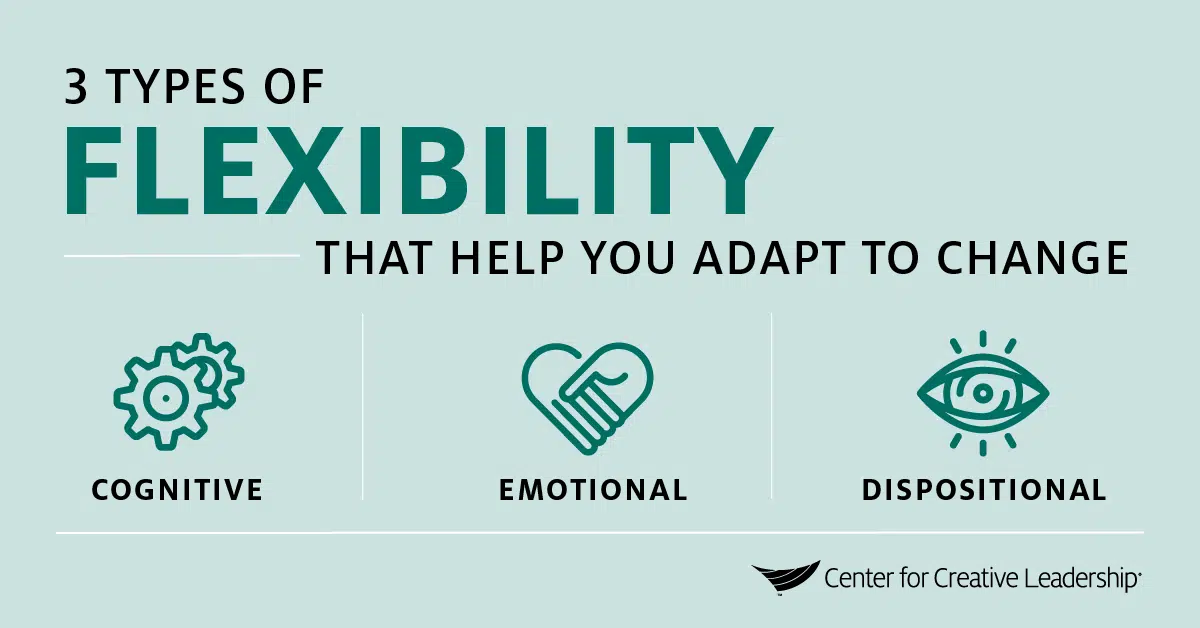How to Be a More Flexible Leader
Now more than ever before, leaders all over the world are facing change and complexity — the coronavirus pandemic has presented us all with new challenges, new circumstances, and new uncertainties in the workplace. Jobs have been morphing, expanding, shrinking, and disappearing; co-workers, teammates, and technology are changing rapidly.
And as we seem to be turning a corner with vaccines and organizations are gradually shifting back to in-person work, there will be a new set of norms to adapt to and challenges to overcome.
Adaptability is a requirement. Because change is constant and inevitable, leaders must be flexible to succeed.
Our research confirms this imperative to adapt. Adaptability is about having ready access to a range of behaviors that enable leaders to shift and experiment as things change.
Here’s what adapting to change for successful executives means in North America and Europe:
- Adapt to the changing external pressures facing the organization;
- Adjust their management style to changing situations;
- Accept changes as positive;
- Revise plans as necessary; and
- Consider other people’s concerns during change.
Conversely, the inability to develop or adapt was the most frequently cited reason for career derailment among North American managers.
That’s because inflexible leaders limit the workplace adaptability of others. New initiatives may be halted or stifled. Resistance to change may undermine critical projects or system-wide implementation, causing not only setbacks in progress, but also leading to anxiety and negative emotions from other team members. Employee enthusiasm, cooperation, morale, and creativity are jeopardized, making it all the more difficult to run the business or organization. (Learn more about how flexible leaders keep their career on track and avoid derailment.)
Do You Show Flexible Leadership? How Well Do You Adapt to Change?
Consider your personal approach to change. How do you respond when adapting to change? Do you:
- Accept the change as positive?
- See the change as an opportunity?
- Adapt plans as necessary?
- Quickly master new technology, vocabulary, operating rules?
- Lead the change by example?
- Take into account other people’s concerns?
- Sort out your strengths and weaknesses fairly accurately?
- Admit personal mistakes, learn from them, and move on?
- Remain optimistic?
If few or none of these responses describes you, you’re not alone. Many of us get stuck, experience anxiety with change, have a hard time letting go, or simply don’t know how to proceed in unknown territory.
As noted in our guidebook Adaptability: Responding Effectively to Change, to survive change in your organization, industry, or profession, you must first lead yourself through the process of transition. This includes finding ways to help yourself feel more grounded amidst potential negative emotions, understanding the impact that change is having on you, and understanding the impact of your behavior on others.
When you are involved in leading change, remember that there are 4 core questions that every employee wants answered:
- What is happening?
- Why is it happening?
- How will this affect me and my job?
- What’s the plan for getting there?
Being proactive and answering these questions before they ask can be beneficial. Learn more about our recommendations on how to transition through change.
Accepting Change & Assessing Your VIEW for More Flexible Leadership
Once you’ve evaluated your response to change, it’s important to consider the way your view models the way for others in your organization to embrace change. Employees take cues from their leaders about how to respond — which is why you need your own point of VIEW of how to accept, embrace, and lead through change. A leader must be:
- Visionary. Focus on today’s results while also imagining the future. Be willing to challenge the status quo, take calculated risks, and anticipate the unexpected.
- Inspiring. Sell the vision and its benefits. Be passionate, model the intended change, and encourage employees to join the changing future.
- Enthusiastic. Maintain a positive, focused attitude that energizes others to overcome barriers. Be persistent and involve others to collaborate.
- Wise. Exude business acumen and knowledge of the organization, its people, and processes. Be able to anticipate and address issues as a problem solver.
The 3 Types of Flexibility That Aid Leaders in Adapting to Change
If you want to improve your ability to adapt to change, practice the 3 components of adaptability in the workplace: cognitive flexibility, emotional flexibility, and dispositional flexibility.
1. Cognitive Flexibility.
Leverage the ability to use different thinking strategies and mental frameworks.
Leaders who have cognitive flexibility are able to incorporate different thinking strategies and mental frameworks into their planning, decision-making, and management of day-to-day work. They can simultaneously hold multiple scenarios in mind and can see when to shift and inject a change.
Cognitive flexibility indicates nimble, divergent thinking, an interest in developing new approaches, the ability to see and leverage new connections, and the propensity to work well across the organization. These leaders readily learn from experience and recognize when old approaches don’t work.
2. Emotional Flexibility.
Harness the ability to vary one’s approach to dealing with emotions and those of others.
Leaders with emotional flexibility vary their approach to dealing with their own and others’ emotions — an area that many leaders often fail to consider. An emotionally flexible leader is comfortable with the process of transition, including grieving, complaining, anxiety, and resistance.
Adapting to change requires give and take between the leader and those experiencing the change. A leader without emotional flexibility is dismissive of others’ concerns and emotions and shuts down discussion. At the same time, an emotionally adaptive leader moves the change or agenda forward.
3. Dispositional Flexibility.
Practice the ability to remain optimistic and, at the same time, realistic.
Leaders who display dispositional flexibility (or personality-related flexibility) operate from a place of optimism grounded in realism and openness. They will acknowledge a bad situation but simultaneously visualize a better future. They are neither blindly positive nor pessimistic and defeatist. Ambiguity is well-tolerated.
Dispositionally flexible leaders see change as an opportunity rather than as a threat or danger.
By learning and practicing behaviors that boost your cognitive, emotional, and dispositional flexibility, you can become more adaptable and, in turn, help others to adapt.
How to Adapt to Change: 5 Tips for More Flexible Leadership
As noted in our white paper on adaptable leadership, executives who display adaptability are flexible. They seek new and innovative ways to solve problems, master new skills, and view disruption as a challenge rather than a threat — all needed to prevail through uncertain times.
As a leader, you not only have to respond to change in the workplace, but you also have to the steer change. Use these 5 tips to effectively adapt to change and guide your team forward:
- Be curious. Ask lots of questions. Wonder, explore, and consider before you judge and decide.
- Don’t get too attached to a single plan or strategy. Have Plan B (and C) at the ready.
- Create support systems. Don’t go it alone. Look to mentors, friends, coaches, trusted peers, professional colleagues, family members, and others to serve as your support system in times of change. Encourage employees to do the same.
- Understand your own reactions to change. You have to be clear about your own emotions and thoughts about changes, so you can be straightforward with others.
- Immerse yourself in new environments and situations. Do this when you are confronted by change — but get practice by joining activities, meeting new people, and trying new things on a regular basis.
Want to know more about how to become a more flexible leader? Watch our webinar, How to Foster Flexible Leadership in Times of Instability.
Ready to Take the Next Step?
Build flexible leaders on your team with the capacity to adapt to change effectively. Partner with us to craft a customized learning journey for your leaders using our research-backed modules. Available leadership topics include Emotional Intelligence, Leadership Agility, Leading Through Change & Disruption, Psychological Safety, and more.










